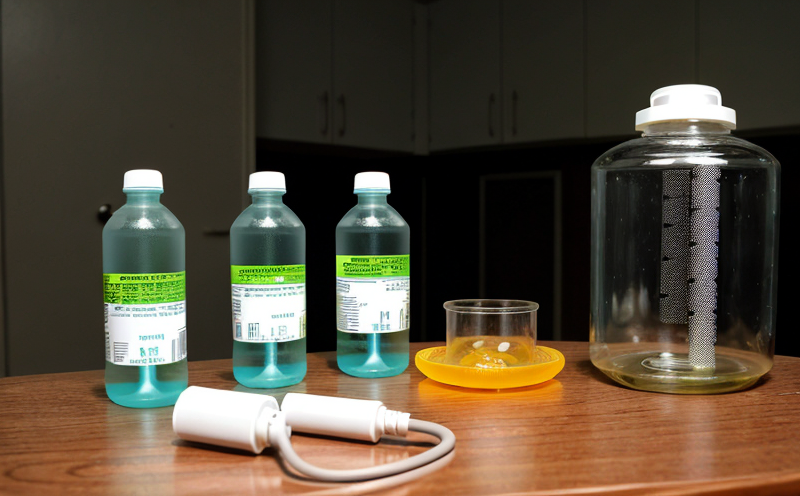ASTM D7285 Actinium 227 Determination Test in Water
The ASTM D7285 test method is a critical standard for the determination of actinium-227 (Ac-227) in water samples. This test is essential for ensuring compliance with regulatory standards and providing accurate data on radioactive contaminants present in water sources.
Actinium-227 is an alpha-emitting radionuclide that can be found naturally in uranium-bearing minerals, and its presence in water supplies poses potential health risks if not properly managed. The ASTM D7285 method utilizes high-resolution gamma spectrometry to measure the concentration of Ac-227. This technique involves precise sample preparation and analysis using a calibrated gamma spectrometer.
The test procedure outlined in ASTM D7285 is designed to be robust, with detailed steps for handling water samples, purifying them, and ensuring that they are suitable for gamma spectroscopy measurement. The method specifies the use of specific reference materials and calibration standards to ensure consistent results across different laboratories.
The significance of this test lies in its ability to detect even low levels of Ac-227, which is crucial for maintaining public health and environmental safety. Regulatory agencies often require compliance with limits set by international standards such as ISO 13905 or IAEA guidelines.
Water utilities, research institutions, and government agencies rely on ASTM D7285 to monitor water quality and ensure that levels of Ac-227 do not exceed safe thresholds. This test is particularly important in areas where groundwater supplies are at risk from natural uranium deposits or industrial contamination.
The testing process begins with the collection of water samples, which should be representative of the source being analyzed. Samples must then undergo a series of preparatory steps including filtration and digestion to ensure that Ac-227 can be accurately detected by gamma spectrometry. The use of appropriate sample containers and handling protocols is critical to avoid contamination or degradation of the sample.
The analytical procedure involves placing the prepared water samples into the gamma spectrometer, where they are irradiated with a photon beam that excites the radioactive isotopes present in the sample. The emitted gamma rays are then detected and quantified using sophisticated software algorithms. The results provide a precise measurement of Ac-227 concentration.
ASTM D7285 is just one component of comprehensive water testing programs designed to protect public health and the environment. It complements other tests for radionuclides such as uranium, thorium, and plutonium, which may also be present in water supplies. By accurately determining Ac-227 levels, laboratories can help ensure that drinking water meets or exceeds regulatory standards.
| Step | Description |
|---|---|
| 1. Collection | Collect water samples in acid-washed containers. |
| 2. Filtration | Filtrate through 0.45 µm filter to remove particulates. |
| 3. Digestion | Digest using nitric acid for thorough dissolution of minerals. |
The results from the ASTM D7285 test are typically reported in picocuries per liter (pCi/L) or becquerels per liter (Bq/L). Compliance with regulatory limits is then assessed against these measurements. Laboratories must also ensure that their testing methods adhere to strict quality control protocols, which include regular calibration of equipment and participation in proficiency testing programs.
Understanding the implications of Ac-227 levels requires knowledge of its half-life and decay products. Actinium-227 has a short half-life of about 20 days, meaning that it decays relatively quickly into radium-223 (Ra-223). This makes it essential to measure concentrations soon after sampling to get accurate results.
In conclusion, the ASTM D7285 test is vital for ensuring water safety by providing reliable data on Ac-227 levels. Compliance with this standard helps safeguard public health and supports environmental protection initiatives worldwide.
Industry Applications
- Water utilities: Ensuring compliance with regulatory standards.
- Research institutions: Studying the effects of Ac-227 on ecosystems.
- Government agencies: Monitoring natural and industrial contamination sources.
- Environmental consulting firms: Providing data for remediation projects.
| Aspect | Description |
|---|---|
| Sampling Location | Select representative locations based on potential contamination risks. |
| Sampling Frequency | Sample at least monthly or as required by regulations. |
Quality and Reliability Assurance
The quality of the ASTM D7285 test is ensured through rigorous calibration procedures and adherence to strict protocols. Laboratories must regularly calibrate their gamma spectrometers using certified reference materials. Additionally, participating in inter-laboratory proficiency testing programs provides independent verification of analytical capabilities.
Internal audits are conducted periodically to assess compliance with standard operating procedures (SOPs). These audits cover all aspects of sample handling, preparation, and analysis. External audits by accreditation bodies further ensure that laboratories meet the necessary quality requirements.
Data interpretation is critical for accurate results. Analysts must have extensive training in spectroscopy and radionuclide analysis to correctly interpret gamma ray spectra. Quality assurance programs also include continuous education and professional development opportunities for staff members.
Environmental and Sustainability Contributions
The ASTM D7285 test plays a vital role in environmental protection by helping to identify and mitigate the risks associated with Ac-227 contamination. By providing accurate data on radionuclide levels, this test supports sustainable water management practices.
Water utilities can use the results from this test to implement targeted remediation efforts where necessary. Research institutions can leverage these findings to develop new strategies for managing radioactive waste and reducing environmental impacts. Government agencies benefit from consistent, reliable data when setting policy and regulations related to water quality.





